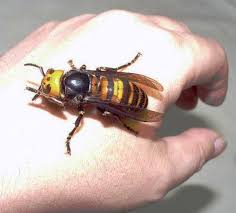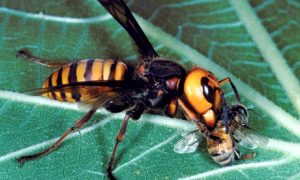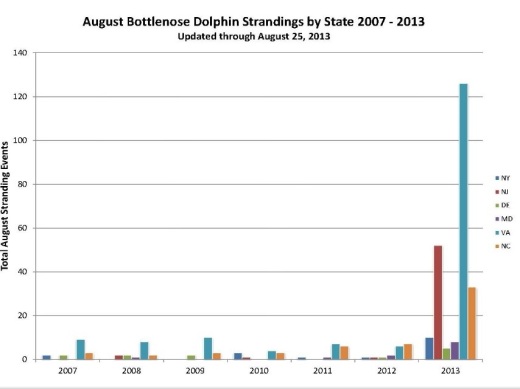

Friday 4 October 2013 05.43 EDT
Chen pointed with a shaky hand at the small plot of cabbage, scallions and corn where his friend Yu Yihong was stung to death by giant hornets.
“When he got to the hospital, there were still two hornets in his trousers,” says Chen, a local farmer who, like many villagers, declined to give his full name to a foreign journalist. “The hornets’ poison was too strong – his liver and kidneys failed, and he couldn’t urinate.”
Yu, a square-jawed 40-year-old farmer in perfect health, had been harvesting his crops when he stepped on a nest of vespa mandarinia hornets concealed beneath a pile of dry corn husks. The hornets swarmed Yu, stinging him through his long-sleeve shirt and trousers. He ran, but the hornets chased him, stinging his arms and legs, his head and neck.
After Yu succumbed to his wounds and about 50 of his friends and relatives gathered to mourn his passing. Outside the farmer’s mountainside home in Yuanba village, they ate preserved eggs, buckwheat noodles and boiled peanuts in silence; one set off a string of fireworks. Yu’s wife and two children sat inside weeping.
Vespa mandarinia is the world’s largest hornet, around the size of a human adult’s thumb, yellow and black in colour and highly venomous. Their 6mm-long stingers carry a venom potent enough to dissolve human tissue. Victims may die of kidney failure or anaphylactic shock.
Yu’s story is a tragic but increasingly common one in north-west China‘s Shaanxi province where, over the past three months alone, hornets have killed 41 people and injured a further 1,675. Ankang, a municipality in the province’s south, appears to be the epicentre of the scourge. While hornets infest its mountainous rural areas every year – 36 residents were stung to death between 2002 and 2005 – locals and municipal officials say this year is tantamount to an epidemic, the worst they have ever seen.
At least some of the deaths were caused by vespa mandarinia, experts say. The species does not typically attack unless it feels its nest is threatened. But when it does, it can be fierce and fast – the hornets can fly at 25 miles per hour and cover 50 miles in a day. They nest in tree stumps or underground, making nests extremely difficult to detect.
Both locals and experts blame this year’s scourge on climate change; the past year has been unusually warm, allowing a high number of hornets to survive the winter. Huang Ronghui, an official at the Ankang Forestry Bureau’s pest control department, lists a host of other possibilities: the hornets may have been agitated by a dry spell, while labourers have been moving deeper and deeper into the mountains, disturbing their nests. “Other than this, hornets are attracted to bright colours and the smell of peoples’ sweat, alcohol and sweet things,” he told state media. “They’re sensitive to movement, such as running people or animals.”
The region has also been overrun by the Asian hornet vespa velutina, a slightly smaller species which can be equally dangerous. Hundreds, even thousands inhabit their nests, which typically hang from high places. In Chengxing village, a few miles downhill from a winding mountain road from Yu’s hometown, 16-year-old Tan Xingjian points at a tree in the distance. Hanging from one thick branch was a pale, basketball-sized bulb, its surface alive with darting black specks. “That’s where they live,” Tan says. “We don’t dare to go near there.”
Ankang is on alert, with the local authorities posting warning notices online, on roadside tree trunks and on primary school walls. The crisis has exhausted Gong Zhenghong, the spiky-haired mayor of Hongshan township in rural Ankang. Since September, Gong has spent nearly every night wandering the township exterminating nests with four other cadres. He says there are 248 hornet nests in Hongshan with 175 are close to schools and roads.
Gong and his team survey nests by day; once the sun sets, they dress in homemade anti-hornet suits made of rain jackets and canvass, and burn the nests with spray-can flamethrowers. “They don’t fly around at night,” he says.
Sometimes, his team begins work in the late evening and doesn’t finish until 2am. “We’d normally send the fire squad to do this, but this year there were too many nests.” Gong left his office, returned with a black rubbish bag, and pulled out the charred remains of a nest, the blackened tails of bulb-like larvae protruding from its combs.
Two other cities in Shaanxi – Hanzhong and Shangluo – have also been besieged by hornets, though the death tolls have been markedly lower. In southern China’s Guangxi Zhuang Autonomous Region, a swarm of hornets attacked a primary school in mid-September, injuring 23 children and seven adults. The teacher, Li Zhiqiang, told pupils to hide under their desks and tried to fight the creatures off until he lost consciousness, state media reported.
The hornets seem ubiquitous in Ankang. In Liushui township, a smattering of two-storey concrete homes sandwiched between a lush hillside and a stagnant river, an elderly shopkeeper in a purple blazer says that the hornets have infested a cabbage patch near her home. “The government has been coming down and burning them, but they can’t burn them all,” she adds, pointing down into the brush. “I’m not willing to go down there.”
Mu Conghui, a 55-year-old Ankang villager, was stung 200 times while tending her rice field in late August. “These hornets are terrifying – all at once they flew to my head, and when I stopped, they stung me so much that I couldn’t budge,” she told state media. “My legs were crawling with hornets. Right now my legs are covered with small sting holes – over the past two months I’ve received 13 dialysis treatments.”
The Ankang government says it has removed 710 hives and sent 7m yuan (£707,000) to help affected areas. “We’re doing everything we can, but there’s only so much we can do,” says Deng Xianghong, the deputy head of the Ankang propaganda department. “God has been unfair to us.”
IPFW Environmental Resources Center



 The
The